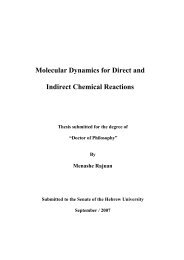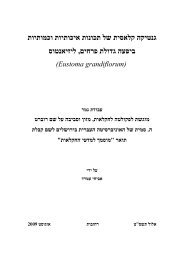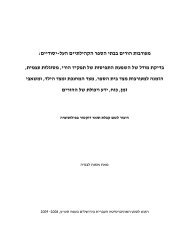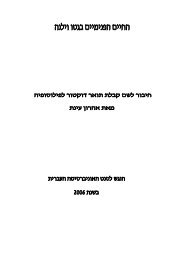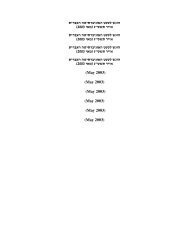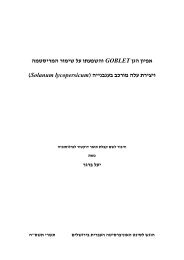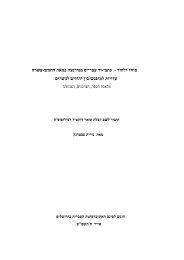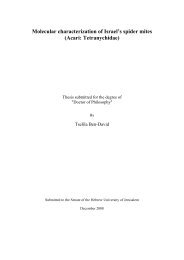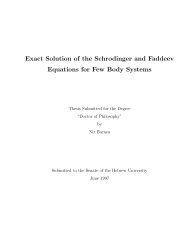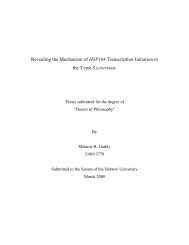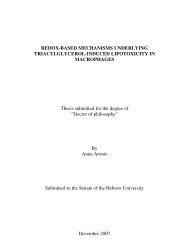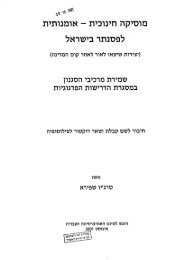The Autecology of Eudiaptomus cf drieschi (Poppe & Mrazek 1895 ...
The Autecology of Eudiaptomus cf drieschi (Poppe & Mrazek 1895 ...
The Autecology of Eudiaptomus cf drieschi (Poppe & Mrazek 1895 ...
Create successful ePaper yourself
Turn your PDF publications into a flip-book with our unique Google optimized e-Paper software.
using a modification <strong>of</strong> the sugar flotation method introduced by Onbe (1978) and<br />
described in Ban & Minoda (1992). Sediments were washed with filtered lake water<br />
(0.45 µm) through a 45.0 µm mesh sieve. Material remaining on the sieve was rinsed<br />
into 250 ml. Nalgene centrifuge bottles, combined with a supersaturated sugar solution<br />
(1 kg per 1 liter), and centrifuged at 3,000 rpm for 5 minutes. <strong>The</strong> supernatant was then<br />
washed through a 20 µm mesh net to remove the sugar and collect the eggs. Eggs were<br />
carefully rinsed into petri-dishes and counted under a Wild binocular dissecting<br />
microscope. Diaptomid eggs were incubated in controlled light and temperature<br />
conditions (Shel-Lab Low Temperature Incubators) in filtered (0.45µm) lake water and<br />
hatching <strong>of</strong> new - born nauplii was recorded.<br />
<strong>The</strong> number <strong>of</strong> benthic resting eggs per gram <strong>of</strong> dry weight sediment was obtained by:<br />
(a / b) * (# eggs / DW (g) ) = # eggs / g (DW) (2)<br />
where a is the wet weight (g) <strong>of</strong> the sediment portion to be dried, b is the wet weight (g)<br />
<strong>of</strong> the sediment portion for egg counts. <strong>The</strong> number <strong>of</strong> eggs per portion is then divided<br />
by the dry weight (DW) <strong>of</strong> sediments. <strong>The</strong>n the density (number <strong>of</strong> eggs per square<br />
meter) was calculated for each sample by finding the number <strong>of</strong> eggs in the surface area<br />
<strong>of</strong> the core ( S.A. = square <strong>of</strong> r * ), which is divided into the number <strong>of</strong> eggs multiplied<br />
by 10 3 .<br />
.2. 3 Diel Survey<br />
Diel sampling took place at Station F on April 1-2 (spring), September 29-30<br />
(fall) 1997, and June 9-10 (summer) 1998. <strong>The</strong> research vessel (RV Hermona) was on<br />
station throughout the survey periods. Duplicate zooplankton samples were taken every<br />
2 hours with a 20 L Schindler - Patalas trap over a 24 hour period (dawn / dusk / dawn).<br />
Zooplankton samples were taken from depths 1, 3, 5, 7, 10, 15, and 1meter from bottom.<br />
Samples were filtered through a 20µm mesh net and preserved in 4% buffered formalin.<br />
Samples were concentrated through a 20µm mesh net to a smaller volume in the lab.<br />
<strong>The</strong> entire sample was counted and all life stages were enumerated with a Wild<br />
binocular, dissecting microscope. <strong>The</strong> parameters: chlorophyll, oxygen, temperature,<br />
light, and Secchi disc depth were measured.<br />
Phytoplankton chlorophyll a samples were taken with a 5-liter Van Dorn bottle<br />
at each sampling depth. <strong>The</strong> water was filtered on-board for size fractionation <strong>of</strong> net



